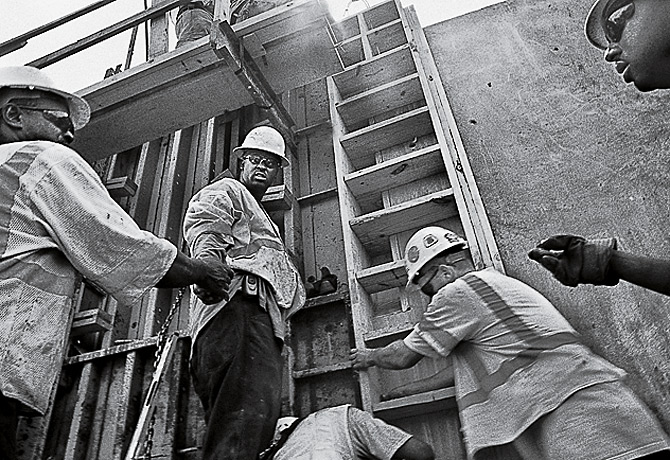
Workers from the Army Corps of Engineers finish the last part of the new flood wall at the 17th Street Canal in New Orleans, La., on July 2, 2007.
(4 of 8)
A Tragedy of Priorities
New Orleans still might have fended off Katrina if its levees hadn't played matador defense. After Hurricane Betsy pummeled New Orleans in 1965, Congress assigned the Corps to protect the city from a 100-year storm. The agency's first mistake was calculating that 100-year event as a modest Category 3 hurricane, even though Betsy had been a 4, and the National Weather Service later proposed a more severe 4. The Corps then made such egregious engineering errors that it wasn't even ready for a smaller storm. For example, its levees sagged as much as 5 ft. (1.5 m) lower than their design because the Corps miscalculated sea level and then failed to adjust for subsidence. Some were built in soils with the stability of oatmeal. "These were inexcusable, lethal mistakes," says University of California, Berkeley, engineering professor Robert Bea, who led a post-Katrina investigation for the National Science Foundation. The Corps also built most of its levees around swampland, a conscious effort to promote the development of low-lying subdivisions like New Orleans East. That no longer seemed like such a good idea after New Orleans East went underwater during Katrina. "That should be the first lesson: build levees around people, not around wetlands," says Paul Harrison of Environmental Defense.
The basic problem is that protecting New Orleans from deadly storms was never anyone's top priority. That's why the city's main hurricane project was 37 years behind schedule when Katrina hit. Louisiana's congressional delegation steered Corps funds toward boondoggles that had nothing to do with flood protection, like a $2 billion effort to channelize the Red River for barges that never materialized. Stingy local officials actually helped scuttle a Corps plan to build pumps and floodgates along Lake Pontchartrain, a plan that could have prevented much of Katrina's flooding. "We can beat ourselves up about the past—or we can use the past to do business differently in the future," says Corps Colonel Jeffrey Bedey, who is now overseeing construction of, yes, huge pumps and floodgates along Lake Pontchartrain. "I don't just mean we the Corps. I mean we the country."
Corps leaders often say their projects simply reflect the will of the nation; when the U.S. wanted them to ransack the landscape with dams and dredges, they saluted and obeyed. But it's also true that the Corps helps shape that will. In recent years the Government Accountability Office, the National Academies of Science and the Pentagon inspector general have documented the agency's bias toward approving projects that keep its 35,000 employees busy and its congressional paymasters happy. In 2000 its leaders were caught cooking an economic analysis to justify a $1 billion upper Mississippi River lock project and launching a secret Program Growth Initiative to lard their budget with make-work. In New Orleans, the Corps endorsed a $750 million lock on the Industrial Canal even though its economists considered it a waste of money; the agency justified it by citing increasing use, even though use was decreasing.
Pam Dashiell, a community activist in the Lower Ninth Ward, fought for years against the Gulf Outlet and the Industrial Canal lock, lobbying Corps officials and Louisiana politicians to focus on safety instead. But both projects were on the wish list of the port, the city's most powerful interest. Dashiell remembers the hostility of Congressmen like Democrat William Jefferson, now indicted on corruption charges, and Republican David Vitter, now embroiled in a prostitution scandal. "They said I was an obstructionist," she says. "I was like, Where are your priorities?'" Her working-class Holy Cross neighborhood had one of the highest elevations in New Orleans, but it was nearly wiped out by the surge that blasted up the Gulf Outlet and tore through floodwalls along the Industrial Canal—just a stone's throw from the white-elephant lock project.